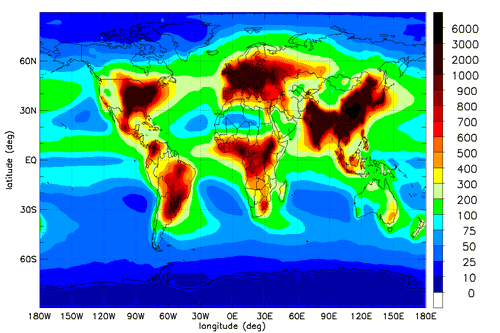How can a substance that makes up the bulk of our atmosphere here on Earth be a pollutant? I’m talking about nitrogen, the most abundant element in the air we breathe, and an extremely important element in plant nutrition. Our atmosphere is 78% nitrogen. But the nitrogen is nonreactive or inert. Plants cannot use it to help them grow and inert nitrogen plays no role in the nitrogen cycle as depicted below.
So How Can Nitrogen be a Pollution Source?
According to most recent headlines coming from China, nitrogen in its reactive form is a major pollutant and is increasingly a problem. Over the last 30 years nitrogen in the environment has increased 60% with the bulk of it coming from transportation, agriculture and industrial sources.
This nitrogen is reactive and a product of modern technological advancements because back in 1909 a chemist named Fritz Haber discovered a way to turn nitrogen into ammonia to use as fertilizer. Today his discovery is a major contributor to the 181 billion kilograms (400 billion pounds) of reactive nitrogen we humans put into our environment every year (based on 2005 data).
What damage is all this reactive nitrogen doing?
- It is responsible for ground-level ozone causing smog, a leading contributor to asthma, respiratory and heart disease.
- It contributes to a number of human illnesses including diseases of the endocrine system, digestive tract cancers, and “blue baby” syndrome caused by infant formula made using high-nitrogen water sources.
- It plays a climate role with nitrous oxide a potent greenhouse gas, and ammonium nitrate fertilizer increasing plant growth on land.
- Runoff from fields treated with it cause algae blooms in lakes, rivers and ocean coastal waters. When the algae dies it causes de-oxygenation in water creating dead zones.
The map below depicts the deposition of reactive nitrogen largely from human sources. Data represented here was collected in 2000. Note the highest concentrations depicted in the deeper orange, red and brown correlate with areas of high human population, industrialization and agricultural intensification.
China’s Dilemma
The Chinese headlines that appeared last week in newspapers were prompted by a study reported in Nature. Done in part by scientists at the China Agricultural University in Beijing, analysis of data from 270 monitoring sites across the country showed that nitrogen deposition had increased by 60% over 30 years amounting to 8 kilograms (17.6 pounds) per hectare (2.47 acres). This level of deposition was equal to the peak levels recorded in Northwestern Europe in the 1980s before remediation measures were introduced there.
How is this impacting the flora of China? Besides nitrogen uptake in a range of leafy plants increasing by 33%, and 16% in rice, wheat and corn, the coastlines of China have become inundated by algae growth (see image below).
Most of the reactive nitrogen comes from air pollutants and not fertilizer with the burning of coal and increases in motor vehicles the major contributors. The former has increased threefold, and the latter twenty-fold in the same thirty-year period used for the study. And researchers forecast an eightfold increase in reactive nitrogen by 2050 if current trends persist.
In a meeting of the American Chemical Society in Denver in August 2011, Alan Townsend, a research scientist at the University of Colorado, remarked, “It’s been said that nitrogen pollution is the biggest environmental disaster that nobody has heard of……People can see an oil slick on the ocean, but hundreds of tons of nitrogen spill invisibly into the soil, water and air every day from farms, smokestacks and automobile tailpipes. But the impact is there — unhealthy air, unsafe drinking water, dead zones in the ocean, degraded ecosystems and implications for climate change. But people don’t see the nitrogen spilling out, so it is difficult to connect the problems to their source.”
Steps China Can Take to Reduce Reactive Nitrogen Pollution
- On a rapid pace to industrialize and increase food supplies, Chinese farmers today use 600 kilograms of nitrogen per hectare per year. A reduction of two-thirds would not affect crop yields but would certainly reduce the amount of nitrogen pollution entering the soil and rivers.
- Chinese farmers are growing livestock feed in greater quantities to deal with increased demand for meat and dairy products from a rising middle class. The manure and sewage coming from these sources represents a further nitrogen pollution threat which can be mitigated by using the waste as fertilizer.
- The move away from coal-fired power plants replacing them with nuclear, wind, solar and hydro renewable sources will lower reactive nitrogen pollutants.
- China’s push to hybrid and electric vehicles to replace those operating using internal combustion and diesel engines will also help to dramatically reduce reactive nitrogen in the environment.
- Conservation and increased energy efficiency will mean reducing required energy capacity and consequently mitigate the amount of reactive nitrogen getting into the environment.
- Better sanitation, boiling and treatment of water to reduce reactive nitrogen levels will have a positive impact on cancer rates and infant mortality.


















